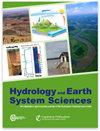Remote quantification of the trophic status of Chinese lakes
IF 5.8
1区 地球科学
Q1 GEOSCIENCES, MULTIDISCIPLINARY
引用次数: 2
Abstract
Abstract. Assessing eutrophication in lakes is of key importance, as this parameter constitutes a major aquatic ecosystem integrity indicator. The trophic state index (TSI), which is widely used to quantify eutrophication, is a universal paradigm in the scientific literature. In this study, a methodological framework is proposed for quantifying and mapping TSI using the Sentinel Multispectral Imager sensor and fieldwork samples. The first step of the methodology involves the implementation of stepwise multiple regression analysis of the available TSI dataset to find some band ratios, such as blue/red, green/red and red/red, which are sensitive to lake TSI. Trained with in situ measured TSI and match-up Sentinel images, we established the XGBoost of machine learning approaches to estimate TSI, with good agreement (R2= 0.87, slope = 0.85) and fewer errors (MAE = 3.15 and RMSE = 4.11). Additionally, we discussed the transferability and applications of XGBoost in three lake classifications: water quality, absorption contribution and reflectance spectra types. We selected XGBoost to map TSI in 2019–2020 with good-quality Sentinel-2 Level-1C images embedded in the ESA to examine the spatiotemporal variations of the lake trophic state. In a large-scale observation, 10 m TSI products from 555 lakes in China facing eutrophication and unbalanced spatial patterns associated with lake basin characteristics, climate and anthropogenic activities were investigated. The methodological framework proposed herein could serve as a useful resource for continuous, long-term and large-scale monitoring of lake aquatic ecosystems, supporting sustainable water resource management.中国湖泊营养状况的远程定量研究
摘要评估湖泊富营养化至关重要,因为这一参数构成了主要的水生生态系统完整性指标。营养状态指数(TSI)被广泛用于量化富营养化,是科学文献中的通用范式。在这项研究中,提出了一种方法框架,用于使用Sentinel多光谱成像仪传感器和实地工作样本来量化和绘制TSI。该方法的第一步涉及对可用的TSI数据集进行逐步多元回归分析,以找到一些对湖泊TSI敏感的波段比率,如蓝/红、绿/红和红/红。使用原位测量的TSI和匹配的Sentinel图像进行训练,我们建立了XGBoost的机器学习方法来估计TSI,一致性好(R2= 0.87,斜率= 0.85),误差更小(MAE = 3.15, RMSE = 4.11)。此外,我们还讨论了XGBoost在三种湖泊类型(水质、吸收贡献和反射光谱类型)中的可转移性及其应用。我们选择XGBoost,利用ESA中嵌入的高质量Sentinel-2 Level-1C图像,绘制2019-2020年湖泊营养状态的时空变化图。对中国555个湖泊的10 m TSI产品进行了大尺度观测,研究了湖泊富营养化及其与湖泊流域特征、气候和人为活动相关的不平衡空间格局。本文提出的方法框架可为湖泊水生生态系统的连续、长期和大规模监测提供有用的资源,支持可持续水资源管理。
本文章由计算机程序翻译,如有差异,请以英文原文为准。
求助全文
约1分钟内获得全文
求助全文
来源期刊

Hydrology and Earth System Sciences
地学-地球科学综合
CiteScore
10.10
自引率
7.90%
发文量
273
审稿时长
15 months
期刊介绍:
Hydrology and Earth System Sciences (HESS) is a not-for-profit international two-stage open-access journal for the publication of original research in hydrology. HESS encourages and supports fundamental and applied research that advances the understanding of hydrological systems, their role in providing water for ecosystems and society, and the role of the water cycle in the functioning of the Earth system. A multi-disciplinary approach is encouraged that broadens the hydrological perspective and the advancement of hydrological science through integration with other cognate sciences and cross-fertilization across disciplinary boundaries.
 求助内容:
求助内容: 应助结果提醒方式:
应助结果提醒方式:


